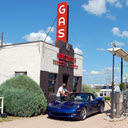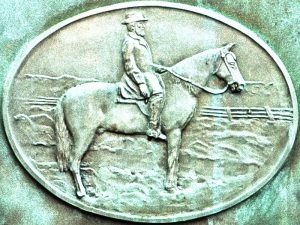 Like the Madonna of the Trail monuments in an earlier My Caboodles chapter, these, too, are a natural for me. Like the Madonnas, they are markers along the side of a famous historic highway that I have traveled. But there are significant differences. The biggest is that the primary purpose of these markers was not to mark the highway but to promote the memory of Confederate General Robert E. Lee. This aspect is discussed a bit more in an earlier post, Free? Advertising on the Dixie. In this post, I’ll just present the markers in the sequence I discovered them.
Like the Madonna of the Trail monuments in an earlier My Caboodles chapter, these, too, are a natural for me. Like the Madonnas, they are markers along the side of a famous historic highway that I have traveled. But there are significant differences. The biggest is that the primary purpose of these markers was not to mark the highway but to promote the memory of Confederate General Robert E. Lee. This aspect is discussed a bit more in an earlier post, Free? Advertising on the Dixie. In this post, I’ll just present the markers in the sequence I discovered them.
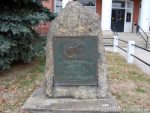
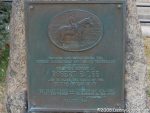 1. In 2008, when I stumbled upon this marker in front of the Madison County courthouse in Marshall, North Carolina, I had no idea there were others. I was excited to find something with a Dixie Highway reference but even then I must have felt it was off-target just a bit. In my journal, I said, “At least it’s sort of a Dixie Highway marker.” On the morning of November 5, 2020, it was discovered that this plaque had been pried from its stone. Erected 1926.
1. In 2008, when I stumbled upon this marker in front of the Madison County courthouse in Marshall, North Carolina, I had no idea there were others. I was excited to find something with a Dixie Highway reference but even then I must have felt it was off-target just a bit. In my journal, I said, “At least it’s sort of a Dixie Highway marker.” On the morning of November 5, 2020, it was discovered that this plaque had been pried from its stone. Erected 1926.
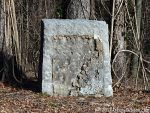
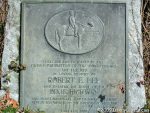
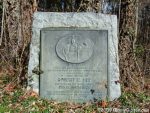 2. Just a couple of months after discovering the marker in Marshall, I took my first picture of the marker at the NC-SC state line. By then I was aware of the eight markers in the Carolinas, but not of the two outliers. In October 2017, vandals pried the plaque from the marker and its whereabouts are unknown. The third photo was taken in December 2017. Erected 1928.
2. Just a couple of months after discovering the marker in Marshall, I took my first picture of the marker at the NC-SC state line. By then I was aware of the eight markers in the Carolinas, but not of the two outliers. In October 2017, vandals pried the plaque from the marker and its whereabouts are unknown. The third photo was taken in December 2017. Erected 1928.

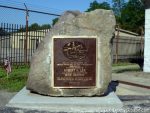
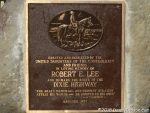 3. By January 2012, I’d learned of two markers outside the Carolinas. Discovering that one was less than 18 miles north of where I live was actually shocking. In August 2017, just a couple of months before the plaque was ripped from the NC-SC state line marker, this one near Franklin, Ohio, was the target of planned demonstrations and counter-demonstrations. The city shortcircuited things by removing the rock and plaque in the middle of the night. The monument has since been returned to public view on private property about two and a half miles north of its original location. Erected 1927.
3. By January 2012, I’d learned of two markers outside the Carolinas. Discovering that one was less than 18 miles north of where I live was actually shocking. In August 2017, just a couple of months before the plaque was ripped from the NC-SC state line marker, this one near Franklin, Ohio, was the target of planned demonstrations and counter-demonstrations. The city shortcircuited things by removing the rock and plaque in the middle of the night. The monument has since been returned to public view on private property about two and a half miles north of its original location. Erected 1927.

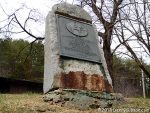 4. On the second day of my 2014 Christmas trip, I reached all of the Carolina markers which included six I’d not seen before. Just as the second marker I photographed was barely inside the state’s southern border, the first one of this outing was barely inside its northern border with Tennessee. Erected 1928.
4. On the second day of my 2014 Christmas trip, I reached all of the Carolina markers which included six I’d not seen before. Just as the second marker I photographed was barely inside the state’s southern border, the first one of this outing was barely inside its northern border with Tennessee. Erected 1928.
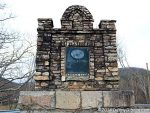
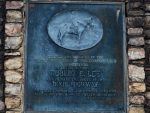 5. I believe of all the Lee-Dixie markers I must have driven by without noticing, I’m baffled the most by this one mounted in a huge brick base in Hot Springs. Erected 1926.
5. I believe of all the Lee-Dixie markers I must have driven by without noticing, I’m baffled the most by this one mounted in a huge brick base in Hot Springs. Erected 1926.
ADDENDUM 16-May-2024: This plaque was stolen in March 2022. Discussions by city officials over whether to replace the plaque with a replica or something different were continuing as of May 1, 2024. Discussions and plans have been hampered by uncertainty as to who owns the land where the marker stands.
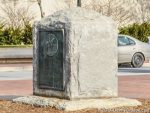
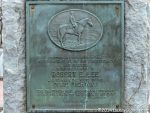
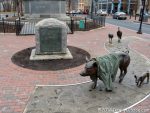 6. The next marker in geographic sequence was the one in Marshall but the next new-to-me marker was in downtown Asheville where it shares space with the 65 foot tall Vance Memorial and a tribute to Drover’s Road. On the day I took my picture, someone had draped a shirt over one of the Drover’s Road pigs. At about the same time that the plaque was pried from the NC-SC marker, an attempt was made to do the same here. The bent corner in the blurry drive-by picture is evidence of that. The face was also badly scratched in a subsequent attack. On July 10, 2020, the marker was removed and put into storage. Erected 1926.
6. The next marker in geographic sequence was the one in Marshall but the next new-to-me marker was in downtown Asheville where it shares space with the 65 foot tall Vance Memorial and a tribute to Drover’s Road. On the day I took my picture, someone had draped a shirt over one of the Drover’s Road pigs. At about the same time that the plaque was pried from the NC-SC marker, an attempt was made to do the same here. The bent corner in the blurry drive-by picture is evidence of that. The face was also badly scratched in a subsequent attack. On July 10, 2020, the marker was removed and put into storage. Erected 1926.
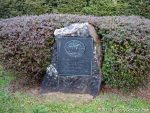
 7. I failed to pick out the marker in Fletcher when I drove by it the first time but I did better on my second pass. On pass number two, I was able to spot it trying to blend into the shrubbery. Erected in 1926.
7. I failed to pick out the marker in Fletcher when I drove by it the first time but I did better on my second pass. On pass number two, I was able to spot it trying to blend into the shrubbery. Erected in 1926.
ADDENDUM 27-May-2023: I have just learned that the plaque was removed from this marker in October 2020. According to information here, the removal was initiated by the church where the boulder stands and the plaque was returned to the United Daughters of the Confederacy.
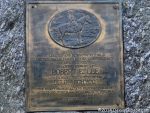
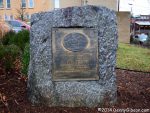 8. The marker in Hendersonville wasn’t particularly hard to spot. It’s a tradeoff but I think I prefer a little tougher hunt and the shrub as background rather than the red car. Erected 1926.
8. The marker in Hendersonville wasn’t particularly hard to spot. It’s a tradeoff but I think I prefer a little tougher hunt and the shrub as background rather than the red car. Erected 1926.
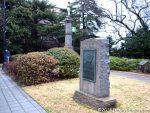
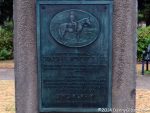 9. Geographically, the next marker was the already photographed one at the NC-SC state line. That meant the next new-to-me marker was the lone South Carolina marker in Greenville. It’s actually a block off of the Dixie Highway but I don’t know whether it was moved to be with a group of Confederate monuments or was originally erected there. Aside from its placement, the marker is unusual in that it identifies a specific United Daughters of the Confederacy chapter rather than the overall organization which makes the plaque a bit taller than the others. It was also erected several years later than any other Lee-Dixie marker and several years after the Dixie Highway ceased to formally exist. Erected 1935.
9. Geographically, the next marker was the already photographed one at the NC-SC state line. That meant the next new-to-me marker was the lone South Carolina marker in Greenville. It’s actually a block off of the Dixie Highway but I don’t know whether it was moved to be with a group of Confederate monuments or was originally erected there. Aside from its placement, the marker is unusual in that it identifies a specific United Daughters of the Confederacy chapter rather than the overall organization which makes the plaque a bit taller than the others. It was also erected several years later than any other Lee-Dixie marker and several years after the Dixie Highway ceased to formally exist. Erected 1935.
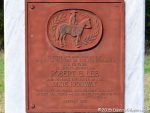
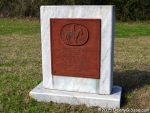 10. I completed the caboodle several days later when I reached the only marker in Florida. It was placed about the same time as most of the others and the text is quite standard, but it is unique in other ways. The most obvious differences are the smooth marble base rather than a rough boulder and a plaque that appears to be made of steel rather than bronze. Lastly, the image of Lee is similar but not identical to the others. Erected 1927.
10. I completed the caboodle several days later when I reached the only marker in Florida. It was placed about the same time as most of the others and the text is quite standard, but it is unique in other ways. The most obvious differences are the smooth marble base rather than a rough boulder and a plaque that appears to be made of steel rather than bronze. Lastly, the image of Lee is similar but not identical to the others. Erected 1927.
I had started towards home when I stopped at the Florida marker, but before I actually reached home, I drove by the Ohio marker just so I could say I saw all ten on the same trip.

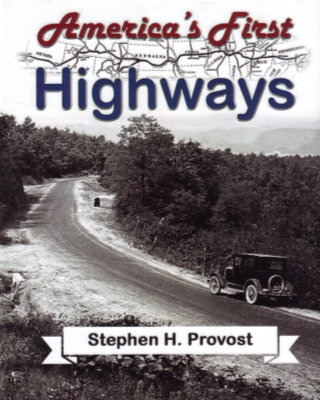 I knew nothing of this book or its author until just before it was reviewed in the Jefferson Highway Association newsletter, The Declaration. The only reason I learned of it that early was because the reviewer, Wayne Shannon, is a friend whom I happened to chat with by phone while he was putting his review together. He was quite positive in talking about the book but, like me, unfamiliar with the name Stephen H. Provost.
I knew nothing of this book or its author until just before it was reviewed in the Jefferson Highway Association newsletter, The Declaration. The only reason I learned of it that early was because the reviewer, Wayne Shannon, is a friend whom I happened to chat with by phone while he was putting his review together. He was quite positive in talking about the book but, like me, unfamiliar with the name Stephen H. Provost.